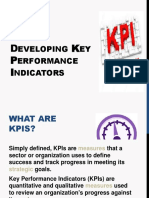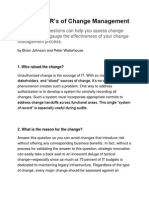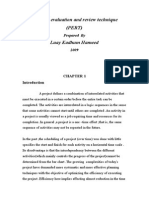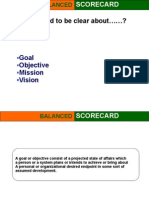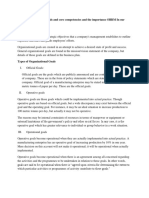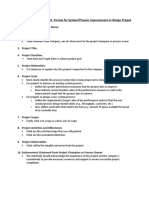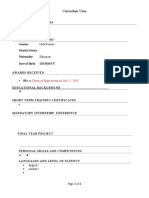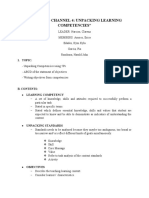0 ratings0% found this document useful (0 votes)
47 viewsSPM Presentation1
SPM Presentation1
Uploaded by
addisuThis document provides information on key performance indicators (KPIs) including:
1. A list of group members and the chapter topics to be covered, including the meaning and importance of performance indicators, types of performance measures, characteristics of KPIs, developing KPIs, and collecting performance data.
2. Descriptions of KPIs, their characteristics including being specific, measurable, attainable and timely. Types of KPIs include generic and specific indicators.
3. The steps involved in developing good KPIs which include identifying strategic objectives, developing key performance questions, choosing areas to measure, and consulting stakeholders.
Copyright:
© All Rights Reserved
Available Formats
Download as PPTX, PDF, TXT or read online from Scribd
SPM Presentation1
SPM Presentation1
Uploaded by
addisu0 ratings0% found this document useful (0 votes)
47 views45 pagesThis document provides information on key performance indicators (KPIs) including:
1. A list of group members and the chapter topics to be covered, including the meaning and importance of performance indicators, types of performance measures, characteristics of KPIs, developing KPIs, and collecting performance data.
2. Descriptions of KPIs, their characteristics including being specific, measurable, attainable and timely. Types of KPIs include generic and specific indicators.
3. The steps involved in developing good KPIs which include identifying strategic objectives, developing key performance questions, choosing areas to measure, and consulting stakeholders.
Original Title
SPM Presentation1.pptx
Copyright
© © All Rights Reserved
Available Formats
PPTX, PDF, TXT or read online from Scribd
Share this document
Did you find this document useful?
Is this content inappropriate?
This document provides information on key performance indicators (KPIs) including:
1. A list of group members and the chapter topics to be covered, including the meaning and importance of performance indicators, types of performance measures, characteristics of KPIs, developing KPIs, and collecting performance data.
2. Descriptions of KPIs, their characteristics including being specific, measurable, attainable and timely. Types of KPIs include generic and specific indicators.
3. The steps involved in developing good KPIs which include identifying strategic objectives, developing key performance questions, choosing areas to measure, and consulting stakeholders.
Copyright:
© All Rights Reserved
Available Formats
Download as PPTX, PDF, TXT or read online from Scribd
Download as pptx, pdf, or txt
0 ratings0% found this document useful (0 votes)
47 views45 pagesSPM Presentation1
SPM Presentation1
Uploaded by
addisuThis document provides information on key performance indicators (KPIs) including:
1. A list of group members and the chapter topics to be covered, including the meaning and importance of performance indicators, types of performance measures, characteristics of KPIs, developing KPIs, and collecting performance data.
2. Descriptions of KPIs, their characteristics including being specific, measurable, attainable and timely. Types of KPIs include generic and specific indicators.
3. The steps involved in developing good KPIs which include identifying strategic objectives, developing key performance questions, choosing areas to measure, and consulting stakeholders.
Copyright:
© All Rights Reserved
Available Formats
Download as PPTX, PDF, TXT or read online from Scribd
Download as pptx, pdf, or txt
You are on page 1of 45
KEY PERFORMANCE INDICATOR /KPIs/
GROUP TWO MEMBERS
1.Alemayehu Gebeyehu
2.Birhanu
3.Gebeyehu Tirusew
4.Meseret Asemare
5.Wubale Asmamaw
6.Zelalem Shitie
CONTENT TO BE COVERED
CHAPTER SEVEN
7.1 Meaning of performance indicators
Types of PM
KPI Characteristics
Types of KPIs
Types of KPIs Indicators
Development of KPIs
7.2. Importance of performance indicators
7.3. Steps in designing of performance indicators
7.4. Performance data collection
Meaning of performance indicators
• Performance indicators are performance assessment criterions against
which organizations asses their actual performance.
• performance indicator as something that allows us to identify to what degree
a variable is present.
• Indicators are the input that allows us to assess performance.
• Performance indicators are performance assessment yards that provide us
with the information and evidence that help us
-gain new insights,
-enable us to learn,
-assist us in our decision making and
-allow us to act on it to improve future performance.
Types of PM
• There are three types of performance measures:
1. Key result indicators (KRIs) - tell you how you have
done in a perspective.
2. Performance indicators (PIs) - tell you what to do.
3. Key Performance Indicators (KPIs) - tell you what to
do to increase performance dramatically.
What are KPIs?
• Simply defined, KPIs are measures that a sector or
organization uses to define success and track progress in
meeting its strategic goals.
• Key Performance Indicators (KPIs) are quantitative and
qualitative measures used to review an organization's
progress against its goals.
• KPIs provide a measurement tool
What are KPIs?
• KPIs represent a set of measures focusing on those
aspects of organizational performance that are the most
critical for the current and future success of the
organization.
• KPIs measure performance by showing trends to
demonstrate that improvements are being made over
time.
• KPIs also measure performance by comparing results
against standards or other similar organizations.
KPI Characteristics
KPI characteristics identified in the literature are:
1. Relevant to and consistent with the specific
organization's vision, strategy and objectives.
2. Focused on organization wide strategic value rather
than non-critical local business outcomes.
3. Representative – appropriate to the organization
together with its operational performance.
KPI Characteristics
4. Realistic – fits into the organization ’s constraints and cost
effective;
5. Specific – clear and focused to avoid misinterpretation or
ambiguity;
6. Attainable – requires targets to be set that are observable,
achievable, reasonable and credible under expected
conditions as well as independently validated;
7. Measurable – can be quantified/measured and may be
either quantitative or qualitative;
KPI Characteristics
• Timely – achievable within the given timeframe;
• Understood – individuals and groups know how their
behaviors and activities contribute to overall agency goals;
• Agreed – all contributors agree and share responsibility
within the agency;
• Reported – regular reports are made available to all
stakeholders and contributors;
KPI Characteristics
• Governed – accountability and responsibility is defined
and understood;
• Resourced – the program is cost effective and adequately
resourced throughout its lifetime.
• Assessed – regular assessment to ensure that they remain
relevant.
Characteristics of good KPIs
• People often use the acronym “SMART” to refer to
the characteristics of good performance indicators.
..
Types of KPIs Indicators
• Generic KPIs measure aspects of performance relevant to the
majority of service users and do not target a specific service user
population. For example, the number of service users awaiting
admission from the emergency department for more than six
hours.
• Specific KPIs are related to a specific service user population and
measure particular aspects of care related to those service users.
For example, the percentage of children that have been referred
for speech and language therapy that wait more than three
months from referral to assessment.
Types of Indicators
• KPIs can be classified according to the type of care for
which the measurement process was developed. For
example: preventive, acute or chronic care:
– Preventive care refers to the maintenance of health and
prevention of illness such as in immunization programs.
– Acute care usually refers to care given for a new onset illness
or for a sudden deterioration in chronic conditions and may
involve short term medical care or surgery.
Development of KPIs
• A number of factors should to be considered when developing and evaluating KPIs:
1. Define the audience and use for measurement.
2. Consult with stakeholders and advisory group.
3. Choose the area to measure.
4. Achieve a balance in measurement.
5. Determine selection criteria.
6. Define the indicator
• Identify the target population
• Define the target to be achieved
• Threshold for action
• Action
Define the audience and use for
measurement
• It is important to define the intended audience
-in order to identify and develop a suitable KPI.
• The audience refers to the person or group for whom the KPI will
aid decision-making and can be the service-user, the clinician, the
public, the facility or the healthcare system.
Define the audience and use for
measurement
• It is essential to note that whether the goal of the measurement
is for benchmarking, either internally for quality improvement
purposes or externally against standards or other organizations,
will influence the KPI selection process.
• Before embarking on the performance measurement process, it
is necessary to identify the domains for which the measurement
is intended, which may in turn be dependent on the audience
Consult with stakeholders and advisory group
• There should be consultation with all stakeholders throughout the
data development process.
• Consultation facilitates the identification of the needs of stakeholders
while simultaneously contributes to the acceptance of the selected
KPIs.
Consult with stakeholders and advisory group
• Consultation also facilitates agreement about data elements and
assists in familiarization with the data and standards.
• Consultation with decision-makers can assist in identifying their
information needs and subsequent use for that information.
• Consultation with service providers can also assist in identifying
their information needs, and elicit what data they can provide.
Choose the Area to Measure
• Choosing the area to be measured should be based on the importance
of the problem, service-user safety, potential for improvement and
controllability by health or social care system/professionals
• A healthcare problem is important if it is associated with significant
morbidity and mortality, has high service-user volumes and is costly
to treat.
Importance of performance indicators
• A performance indicator allows us to collect evidence and
information that
1. helps us gain new insights and learning ,
2. supports our decision making and
3. leads to improved organizational
performance.
Vital points of performance indicators
1. A performance indicator does not necessarily mean counting or
quantifying. Evidence and information can also take the forms of
written descriptions, observations and so on.
Example use of mysteries shopping for call center or focus group
discussion with students.
2. A performance indicator has to be relevant to the information
needs of the organization. It therefore has to be linked to the
strategic priorities of the organization and has to be connected to
the important decisions that have to be made in an organization.
Vital points of performance indicators
3. A performance indicator has to be meaningful : this
means organizations have to
-collect the right information,
-from the right source,
-at the right frequency, and
-we have to provide the evidence and
information
to the right people, in the right format, at the right
time.
Steps in designing of performance indicators
• To facilitate the design of more relevant and meaningful performance
indicators, some scholars proposed the following steps for development of
good performance indicators
Step 1: identification of strategic objectives
Any performance indicator has to be linked to our organizational priorities
and strategic objectives.
- Hence, we should clearly identify our strategic objectives before
development of any indicators.
- Indeed, it is strategic objectives that used as a base to develop
performance indicators and the latter serve to asses the achievement in the
former.
Steps in designing of performance indicators
Step 2: Develop KPQ
• A KPQ is a management question that captures exactly
what it is that people want to know when it comes to
performance of each of the strategic objectives.
• The rationale for KPQs is that they provide guidance for
collecting relevant and meaningful PIs and focus our
attention on what actually needs to be discussed when we
review performance.
Example from BDU STRATEGIC PLAN
ONE OF THE Strategic objective: BDU will design and
execute different strategies and programs with the
intention of promoting staff satisfaction.
• HOW performance indicator can be developed for the
above objective?
THE focus here is Formulation of KPQ: what strategies
and programs do BDU design to ensure staff
satisfaction?
Steps in designing of performance indicators
• N.B. The main reason for strategic performance
management is to improve future performance.
Performance improvement is based on learning.
• Deep and significant learning occurs only as a result of
reflection, and reflection is not possible without a question.
KPQs are therefore essential components of good
performance management.
Steps in designing of performance indicators
KPQs can be extremely powerful management tools as they:
• enable us to design meaningful PIs;
• wake us up and focus our attention;
• help us to think clearly, logically and strategically;
• allow us to challenge the status quo;
• build a culture of engagement and accountability;
• lead to reflection, new insights, learning and performance
improvement.
From where we drive KPQ? From strategic objectives to
KPQs to KPIs
Steps in designing of performance indicators
Step 3: developing of possible PIs corresponding to each KPQ.
Example from BDU
ONE OF THE Strategic objective: BDU will design and execute different strategies and programs with the intention of
promoting staff satisfaction.
• HOW performance indicator can be developed for the above objective?
1. Formulate KPQ: what strategies and programs do BDU design to ensure staff satisfaction?
2. Develop possible performance indicators: some of them can be
- Salary increment
- Resident provision
- Well furnished recreation center (cafeteria, gymnasium, bar and restaurant)
- Transportation service
- Health insurance
- Improve social relationship
- Further education opportunity
- Good leadership ( collegial and supportive relation with supervisors at all level)
Steps in designing of performance indicators
Step 4: Analyze each PIs and develop Limited and focused number of performance
indicators
• N.B. analysis criterions here include
1. The extent to which PI answers the KPQ
2. The extent to which we can collect meaningful data for indicators
3. COST consideration: amount of budget required to collect information
4. The extent to which the indicator help us to make a better decision.
• N.B. If no decisions are made on the data, then no improvements will follow, and the
indicators will be pretty worthless.
• Too often do we end up with data that is interesting to know but which is not really
enabling us to make better informed decisions.
Steps in designing of performance indicators
5. The extent to which the indicator invite cheating
• For instance: If we want to improve service delivery and measure call duration as a key
measure that is tracked by the automated system, then this leaves considerable room
for cheating because call center agents could just hang up – the system wouldn’t know
whether the call was handled satisfactorily or not.
- It is worth to note that no indicator will ever be 100% cheat-proof
- However If the indicator makes it too easy to cheat, it would make sense to reflect on
the indicator, redesign it or not to use.
• - N.B. THE ABOVE FIVE CRITERIONS TAKEN BY SOME SCHOLARS AS A
SEPARATE STEPS.
Step 5: collect performance data
Steps in designing of performance indicators
example in case of BDU: develop Limited and focused PIS
- Based on criterion discussed in this chapter, we should redesign or eliminate some of
PIs
- FOR INSTANCE, salary and provision of insurance need to redesign or eliminate on
the ground of cost ( beyond the university internal revenue generation capacity) or
decision factor ( the university has not legal mandate to decide on such issues and hence
no need to collect information on such indicators since the indicators don't help the
university management to make a better decision).
- Similarly, we need to reconsider the use of improving of social relationship on the
ground of availability and meaningfulness of data in this PI.
- finally we deal with Collection of performance data. This can be done through staff
satisfaction survey or focus group discussion
KPI Key Performance Indicator
KPI Advantages
KPI Advantages
KPI Disadvantages
KPI Disadvantages
Performance data collection
A number of different measurement instruments that can be used to collect
performance data. Major once include:
1. Surveys and questionnaires: commonly used by service providers to asses
their performance in relation with satisfaction of customers. For instance
CS organizations service delivery assessment OR internal employee job
satisfaction assessment and so on
• N.B. It is always a good idea to reduce the amount of time and effort
required to collect performance data, not only for your organization, but
also for your customers, employees, suppliers, etc.
Performance data collection
2. In-depth interviews are guided conversations with people, rather
than structured queries such as surveys.
• Interviews can be conducted face-to-face or via telephone or
videoconference.
• In-depth interviews can, for example, be used to assess elements
such as relationship with key customers, suppliers or partners.
Performance data collection
3. Focus groups are facilitated group discussions (5 – 20
participants) in which participants can express and share their
ideas, opinions and experiences.
• Focus groups are good ways of assessing employee- and
customer-related performance indicators such as customer
experience, customer or staff engagement, team-working climate
or trust.
Performance data collection
4. Mystery shopping approaches are the assessment of a service by a ‘ secret
shopper ’ posing as a client or customer.
For example, instead of the ubiquitous and intrusive customer satisfaction
survey, many service providers, such as hotels or banks, now use focus
groups to identify what really matters to their target customers and then
employ professional mystery shoppers to assess service levels according to
the criteria identified.
5. External assessments: External organizations and institutions can provide
independent performance assessments and indicators.
N.B. external assessment is hardily to provide meaningful information in
politicized environment.
Performance data collection
6. Observations allow us to collect information by observing situations or
activities with little or no manipulation of the environment.
• Observation outputs can take the format of score sheets, checklists,
narrative reports and video- or audio taping.
7. Peer-to-peer evaluation is the assessment of performance in which
participants vote or assess each other’s performance.
• This can either be done openly or anonymously and enables people to
learn from each other and to consider their own performance from the
perspective of other people.
• Peer to- peer evaluations have been successfully used to gauge elements
including trust, knowledge and experience, teamwork and relationships.
…
You might also like
- Mcdonald's Strategic Human Resource ManagementDocument50 pagesMcdonald's Strategic Human Resource Managementpebbles218679% (62)
- Architecture - February 2022Document34 pagesArchitecture - February 2022ArtdataNo ratings yet
- Level of Conceptualization For Leadership TheoriesDocument9 pagesLevel of Conceptualization For Leadership TheoriesUmair Mansoor100% (1)
- English Is Fun Book 1 - Combine PDFDocument127 pagesEnglish Is Fun Book 1 - Combine PDFsarakg vath0% (1)
- SNT-TC-1A 2020 ChangesDocument33 pagesSNT-TC-1A 2020 ChangesShanmuga Navaneethan100% (7)
- Developing Key Performance IndicatorsDocument11 pagesDeveloping Key Performance IndicatorsSindy SellanNo ratings yet
- HR Analytics: Shubham Singhal 80303120053 PGDM NMIMS, HyderabadDocument24 pagesHR Analytics: Shubham Singhal 80303120053 PGDM NMIMS, HyderabadAditi KohliNo ratings yet
- Administrative Professional 1st FileDocument151 pagesAdministrative Professional 1st FileazmityNo ratings yet
- EY The New Age Artificial Intelligence For Human Resource Opportunities and FunctionsDocument11 pagesEY The New Age Artificial Intelligence For Human Resource Opportunities and FunctionsThanh Phương LêNo ratings yet
- The Seven R's of Change ManagementDocument4 pagesThe Seven R's of Change ManagementRajmohan SubbaiahNo ratings yet
- 5 Key Steps of Critical Path Management and Common Fashion Industry ProblemsDocument3 pages5 Key Steps of Critical Path Management and Common Fashion Industry Problemsgowrisankar_kuppusamNo ratings yet
- HR Audit HR Accounting - Module 6Document27 pagesHR Audit HR Accounting - Module 6Aakash KrNo ratings yet
- Building Effective Leadership Skills: Creating Your Own Leadership LegacyDocument19 pagesBuilding Effective Leadership Skills: Creating Your Own Leadership LegacyM ManjunathNo ratings yet
- Program Evaluation and Review Technique (PERT) Luay Kadhum HameedDocument32 pagesProgram Evaluation and Review Technique (PERT) Luay Kadhum HameedRajiv RanjanNo ratings yet
- Do We Need To Be Clear About ?: Goal Objective Mission VisionDocument26 pagesDo We Need To Be Clear About ?: Goal Objective Mission VisionSoumik MukherjeeNo ratings yet
- Tools of Lean MaufacturingDocument22 pagesTools of Lean Maufacturingsahu_dishaNo ratings yet
- Software Project ManagementDocument32 pagesSoftware Project ManagementdivyaNo ratings yet
- Chap 2 Software Project ManagementDocument49 pagesChap 2 Software Project Managementmigad100% (1)
- IEMS Module 2Document17 pagesIEMS Module 2M.José Copons GalloNo ratings yet
- Module 1-Part 3 - Human Resource PlanningDocument76 pagesModule 1-Part 3 - Human Resource PlanningUma Devi AnanthNo ratings yet
- GSD Management PresentationDocument20 pagesGSD Management PresentationLM MuhammadNo ratings yet
- Introduction To ManagementDocument2 pagesIntroduction To ManagementJc JacksonNo ratings yet
- Designing InterventionsDocument8 pagesDesigning InterventionsGopinathan AeNo ratings yet
- Sewing Room Defects PDFDocument6 pagesSewing Room Defects PDFAlemu HaileNo ratings yet
- Agile HR - Buzzword or Building Block?: A Tool To Increase Agility and Responsiveness in HRDocument6 pagesAgile HR - Buzzword or Building Block?: A Tool To Increase Agility and Responsiveness in HRAbhi Kumar100% (1)
- Mine ManagementDocument20 pagesMine ManagementsunilsinghmNo ratings yet
- Operations Manager: - Deliver A Quality Product/service ToDocument23 pagesOperations Manager: - Deliver A Quality Product/service ToakshaynnaikNo ratings yet
- Becoming LeanDocument79 pagesBecoming LeanItqan ArchiaNo ratings yet
- Information Technology (IT) AuditDocument31 pagesInformation Technology (IT) AuditCharmaine ChuaNo ratings yet
- Information Systems Strategic ManagementDocument24 pagesInformation Systems Strategic ManagementKundayi ChinyongoNo ratings yet
- Grievance Handling and DisciplineDocument15 pagesGrievance Handling and DisciplineVinoth KumarNo ratings yet
- Discuss Organizational Goals and Core Competencies and The Importance SHRM in Our Organization. Organizational GoalsDocument11 pagesDiscuss Organizational Goals and Core Competencies and The Importance SHRM in Our Organization. Organizational Goalsconcerned studentNo ratings yet
- A Study On Absenteeism Among Workers at Textile Garment Manufacturing Industries in Coimbatore DistrictDocument7 pagesA Study On Absenteeism Among Workers at Textile Garment Manufacturing Industries in Coimbatore DistrictarcherselevatorsNo ratings yet
- Cost Concepts & ClassificationDocument24 pagesCost Concepts & ClassificationAbhishek MishraNo ratings yet
- Rapid Application Development Model PresentationDocument19 pagesRapid Application Development Model Presentationcosmas crymore MugwandaNo ratings yet
- Lean ManufacturingDocument66 pagesLean Manufacturingmanpreetsodhi08No ratings yet
- IT/IS Infrastructure ManagementDocument41 pagesIT/IS Infrastructure ManagementNarnishNo ratings yet
- Pom 040: Production and Operations ManagementDocument37 pagesPom 040: Production and Operations Managementcharles makasabiNo ratings yet
- A Presentation On Aggregate PlanningDocument17 pagesA Presentation On Aggregate PlanningAhel Patrick VitsuNo ratings yet
- 7 TestingDocument19 pages7 TestingArya StarkNo ratings yet
- IE - $ - & GSD SMV Basic Observed Rating Efficiency Earn Organization UCLDocument3 pagesIE - $ - & GSD SMV Basic Observed Rating Efficiency Earn Organization UCLMohammad MehediNo ratings yet
- Employee EngagementDocument11 pagesEmployee EngagementAdeelSiddiqueNo ratings yet
- CM 05 - Lean Management - Final PresentationDocument74 pagesCM 05 - Lean Management - Final PresentationOmar RefaatNo ratings yet
- Major Perspectives in Leadership TheoryDocument19 pagesMajor Perspectives in Leadership TheoryAnoosha LashariNo ratings yet
- Fire Safety Training-PradipDocument40 pagesFire Safety Training-PradiptizonbruNo ratings yet
- Industrial Management Unit V: Mrs D Pratibha Associate Professor Anurag Group of InstitutionsDocument53 pagesIndustrial Management Unit V: Mrs D Pratibha Associate Professor Anurag Group of InstitutionsD PRATIBHANo ratings yet
- MBA-101 Internal and External EnvironmentDocument19 pagesMBA-101 Internal and External EnvironmentinasapNo ratings yet
- SDLCDocument15 pagesSDLC0006Varun SainiNo ratings yet
- Metrics Framwork RolloutDocument6 pagesMetrics Framwork RolloutAashirtha SNo ratings yet
- KANBANDocument24 pagesKANBANSalwin Joseph ANo ratings yet
- Programme Management and Project EvaluationDocument46 pagesProgramme Management and Project Evaluationadarsh rajNo ratings yet
- Chapter 1 Introducing Information Systems Project ManagementDocument36 pagesChapter 1 Introducing Information Systems Project ManagementmazhariNo ratings yet
- Lean Manufacturing: Presented by Vineeta Kanwal ID No. 44316Document35 pagesLean Manufacturing: Presented by Vineeta Kanwal ID No. 44316Vineeta KanwalNo ratings yet
- Procedure & Role of AccountantDocument8 pagesProcedure & Role of AccountantNur AfiqahNo ratings yet
- Aggregate Planning OPCDocument20 pagesAggregate Planning OPCMaithili PrabhuNo ratings yet
- Project Charter Document: Format For System/Process Improvement or Design ProjectDocument2 pagesProject Charter Document: Format For System/Process Improvement or Design ProjectmarouaNo ratings yet
- Ms. Swati - PPT - HRM - HR Analytics - PGDM - 2019 - Week 2 Session 1 - 30th March 2020Document54 pagesMs. Swati - PPT - HRM - HR Analytics - PGDM - 2019 - Week 2 Session 1 - 30th March 2020AnanyaNo ratings yet
- JOB Analysis Report (Naveena Denim Mills)Document4 pagesJOB Analysis Report (Naveena Denim Mills)NomanNo ratings yet
- Sequence DiagramDocument41 pagesSequence DiagramRawan BasheerNo ratings yet
- Directing CommunicatingDocument21 pagesDirecting CommunicatingAkshay MNo ratings yet
- QcoDocument6 pagesQcosujiviji67No ratings yet
- Software Security Vulnerability A Complete Guide - 2020 EditionFrom EverandSoftware Security Vulnerability A Complete Guide - 2020 EditionNo ratings yet
- Basic Computer Concepts: Network AdministrationDocument2 pagesBasic Computer Concepts: Network AdministrationaddisuNo ratings yet
- BDUTGSH Final Network DesignDocument74 pagesBDUTGSH Final Network DesignaddisuNo ratings yet
- Proposal For AddisuDocument9 pagesProposal For AddisuaddisuNo ratings yet
- Network Design Template FinalDocument16 pagesNetwork Design Template FinaladdisuNo ratings yet
- Bahir Dar University Institute of Technology School of Computing Department of Computer ScienceDocument37 pagesBahir Dar University Institute of Technology School of Computing Department of Computer ScienceaddisuNo ratings yet
- Graduate CV FormatDocument2 pagesGraduate CV FormataddisuNo ratings yet
- Multimedia JournalismDocument2 pagesMultimedia JournalismTrooper_231No ratings yet
- Zambia Customary Land Documentation Tenure Assessment: Tenure and Global Climate Change (TGCC) ProgramDocument35 pagesZambia Customary Land Documentation Tenure Assessment: Tenure and Global Climate Change (TGCC) ProgramLitia AdamsNo ratings yet
- Tutorial 11Document2 pagesTutorial 11ShereenNo ratings yet
- Motorcycle Small Engine Servicing NC IIDocument162 pagesMotorcycle Small Engine Servicing NC IIjuwan decastroNo ratings yet
- Epic Theatre Conventions The Drama TeacherDocument4 pagesEpic Theatre Conventions The Drama Teacherapi-367598270100% (1)
- Containing Byzantine Failures With Control Zones: Disadvantages of Existing SystemDocument4 pagesContaining Byzantine Failures With Control Zones: Disadvantages of Existing SystemThe Futura LabsNo ratings yet
- Standard Operating Procedure (SOP) TTT PUne 2019Document15 pagesStandard Operating Procedure (SOP) TTT PUne 2019Prajyesh Kr YadavNo ratings yet
- List of Journals With Article Processing Charges (APC) - 2Document13 pagesList of Journals With Article Processing Charges (APC) - 2Habtemariam A. KefaleNo ratings yet
- Project1 EnGRAIS FY19 Annual ReportDocument75 pagesProject1 EnGRAIS FY19 Annual ReportHCGFH/NNo ratings yet
- Alsaada, Et Al vs. City of Columbus, Et Al.Document81 pagesAlsaada, Et Al vs. City of Columbus, Et Al.Chanda Brown33% (3)
- ! Communicative English Language Skills II, DTUDocument32 pages! Communicative English Language Skills II, DTUmichael gorgeNo ratings yet
- Dr. Verghese Kurien: Early YearsDocument8 pagesDr. Verghese Kurien: Early YearsChandan K CNo ratings yet
- "Learning Channel 4: Unpacking Learning Competencies": 1. TOPICDocument4 pages"Learning Channel 4: Unpacking Learning Competencies": 1. TOPICBawat PiyesaNo ratings yet
- Lecture NotesDocument1 pageLecture Notessatishbojjawar14840% (1)
- Chapter 11 HandoutDocument20 pagesChapter 11 HandoutJenecelle Cabanag EnciertoNo ratings yet
- People of The Philippines Vs Edwin Concepcion Y Jacinto, Et. AlDocument4 pagesPeople of The Philippines Vs Edwin Concepcion Y Jacinto, Et. AlLacab ShierlyNo ratings yet
- Children's Rights LeafletDocument2 pagesChildren's Rights LeafletDoodah2No ratings yet
- Bhargav K ResumeDocument2 pagesBhargav K ResumeBhargav KindarkhediaNo ratings yet
- French, Dumani, Allen, Et. Al. (2017) Meta-Analysis of Work-Family Conflict and Social SupportDocument32 pagesFrench, Dumani, Allen, Et. Al. (2017) Meta-Analysis of Work-Family Conflict and Social SupportnourinsalehNo ratings yet
- Observation DataDocument8 pagesObservation DataNaga NagendraNo ratings yet
- Computer 9: WEB DESIGN: Cascading Style SheetDocument8 pagesComputer 9: WEB DESIGN: Cascading Style Sheetcoalie galaxyNo ratings yet
- Se Bits 2nd Mid 2-2Document2 pagesSe Bits 2nd Mid 2-2varsha reddyNo ratings yet
- Seven Jump Tutoril Dan CASE 1-8 SBP1Document17 pagesSeven Jump Tutoril Dan CASE 1-8 SBP1Emi DestianiNo ratings yet
- Brainstorming and Outlining An EssayDocument3 pagesBrainstorming and Outlining An EssayMaria Elviranda SimanjuntakNo ratings yet
- Resume BilalDocument1 pageResume BilalBilal AhmedNo ratings yet
- Responsibility and Accountability of A Filipino Teacher: M O D U L E 3Document136 pagesResponsibility and Accountability of A Filipino Teacher: M O D U L E 3Waki RamirezNo ratings yet






